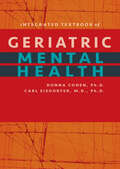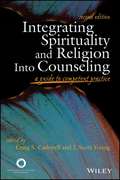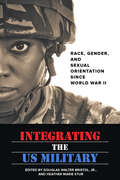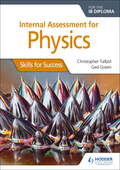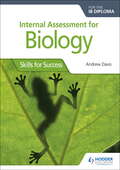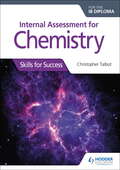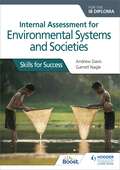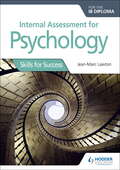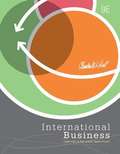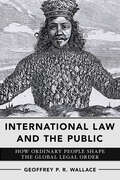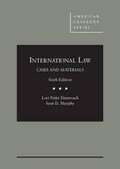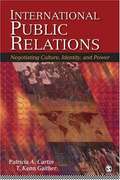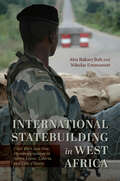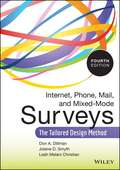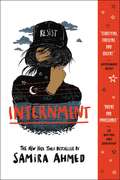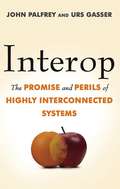- Table View
- List View
Integrated Textbook of Geriatric Mental Health
by Donna Cohen Carl EisdorferAs the population ages, increasing numbers of older people require the attention and services of mental health professionals. Despite their prevalence, however, mental health problems in this population often go undiagnosed and therefore untreated. This textbook offers medical students and professionals the information they need to care for older people with mental disorders.Drs. Donna Cohen and Carl Eisdorfer, two internationally recognized experts in geriatric mental health, provide a comprehensive framework within which students and practitioners alike can address the salient issues of the field. These include the biopsychosocial aging processes, specific pathologies prevalent in later life, social issues common to the elderly, the delivery of care in various settings, and the economic policies affecting services for older people. The authors’ goal is not only to enhance clinical practice but also to urge physicians to develop and coordinate a more holistic care strategy that acknowledges the complex challenges of older patients. To this end, Cohen and Eisdorfer discuss essential principles of optimal care, the latest research findings, evidence- and consensus-based practice standards, resources to help professionals keep abreast of the changing mental health landscape, and ethical dilemmas of clinical practice and research. The signal strength of this book lies in its integrated approach, an approach that emphasizes the philosophy and principles of caring for older people along with clinical practices and issues. From this broader perspective, the authors describe the many factors that influence the lives, health, and well-being of older patients and their caregivers, making this an ideal text for psychiatrists, psychologists, nurses, and social workers.
Integrated Treatment for Dual Disorders: A Guide to Effective Practice
by Robert E. Drake Kim T. Mueser Kim Tornvall Mueser Lindy Fox Douglas L. NoordsyThis comprehensive clinical handbook provides virtually everything needed to plan, deliver and evaluate effective treatment for persons with substance abuse problems and persistent mental illness. From authors at the forefront of the dual disorders field, the book is grounded in decades of influential research. Presented are clear guidelines for developing integrated treatment programmes, performing state-of-the-art assessments, and implementing a wide range of individual, group and family interventions. Also addressed are residential and other housing services, involuntary interventions, vocational rehabilitation, and psychopharmacology for dual disorders. Throughout, the emphasis is on workable ways to combine psychiatric and substance abuse services into a cohesive, unitary system of care. The volume contains all needed assessment forms, treatment planning materials and client handouts, most of which include permission to photocopy.
Integrating Spirituality and Religion Into Counseling: A Guide to Competent Practice
by Craig S. Cashwell J. Scott YoungIn this book, experts in the field consider how spiritual and religious issues can be successfully incorporated into counseling in a manner consistent with client beliefs and practices. Designed as an introductory text for counselors-in-training and clinicians, it describes the knowledge base and skills necessary to effectively engage clients in an exploration of their spiritual and religious lives to further the therapeutic process.
Integrating the US Military: Race, Gender, and Sexual Orientation since World War II
by Douglas Walter Bristol, Jr., and Heather Marie SturHow have the US Armed Forces been transformed by integration?One of the great ironies of American history since World War II is that the military—typically a conservative institution—has often been at the forefront of civil rights. In the 1940s, the 1970s, and the early 2000s, military integration and promotion policies were in many ways more progressive than similar efforts in the civilian world. Today, the military is one of the best ways for people from marginalized groups to succeed based solely on job performance.Integrating the US Military traces the experiences of African Americans, Japanese Americans, women, and gay men and lesbians in the armed forces since World War II. By examining controversies from racial integration to the dismantling of "Don’t Ask, Don’t Tell" to the recent repeal of the ban on women in combat, these essays show that the military is an important institution in which social change is confirmed and, occasionally, accelerated. Remarkably, the challenges launched against the racial, gender, and sexual status quo in the postwar years have also broadly transformed overarching ideas about power, citizenship, and America’s role in the world.The first comparative study of legally marginalized groups within the armed services, Integrating the US Military is a unique look at the history of military integration in theory and in practice. The book underscores the complicated struggle that accompanied integration and sheds new light on a broad range of comparable issues that affect civilian society, including affirmative action, marriage laws, and sexual harassment.
Intensely Alice: Dangerously Alice; Almost Alice; Intensely Alice (Alice #21)
by Phyllis Reynolds NaylorWouldn’t it be great to go back to the time before Pam got pregnant, before Patrick left for the University of Chicago, before anyone was making any big decisions about sex or college or life in general? Wouldn’t it be great to get the whole gang together again, just once? What it takes for this to happen will change Alice (and the whole gang) forever. A funeral is not a happy reunion. Full of life—the good, the bad, and the heartbreaking—this Alice book is a reminder of just how much can change in an instant.
InterAsian Intimacies across Race, Religion, and Colonialism
by Chie IkeyaIn InterAsian Intimacies across Race, Religion, and Colonialism, Chie Ikeya asks how interAsian marriage, conversion, and collaboration in Burma under British colonial rule became the subject of political agitation, legislative activism, and collective violence. Over the course of the twentieth century relations between Burmese Muslims, Sino-Burmese, Indo-Burmese, and other mixed families and communities became flashpoints for far-reaching legal reforms and Buddhist revivalist, feminist, and nationalist campaigns aimed at consigning minority Asians to subordinate status and regulating women's conjugal and reproductive choices. Out of these efforts emerged understandings of religion, race, and nation that continue to vex Burma and its neighbors today.Combining multilingual archival research with family history and intergenerational storytelling, Ikeya highlights how the people targeted by such movements made and remade their lives under the shifting circumstances of colonialism, capitalism, and nationalism. The book illuminates a history of belonging across boundaries, a history that has been overshadowed by Eurocentric narratives about the mixing of white colonial masters and native mistresses. InterAsian intimacy was—and remains—foundational to modern regimes of knowledge, power, and desire throughout Asia.
Interference (Arthur A Levine Novel Bks.)
by Kay HoneymanFriday Night Lights meets Jane Austen's Emma in this wonderful novel about a big election, big games, the big state of Texas, and a little romance.As a Congressman's daughter in Washington, D.C., Kate Hamilton is good at getting what she wants -- what some people might call "interfering." But when her family moves to West Texas so her dad can run in a special election, Kate encounters some difficulties that test all her political skills. None of her matchmaking efforts go according to plan. Her father's campaign gets off to a rough start. A pro tip for moving to Texas: Don't slam the star quarterback's hand in a door. And whenever Kate messes up, the irritatingly right (and handsome) Hunter Price is there to witness it. But Kate has determination and a good heart, and with all her political savvy -- and a little clever interference -- she'll figure out what it takes to make Red Dirt home. Terrifically funny and sweetly romantic, with whip-crack dialogue and a wise perspective on growing up, Interference is the perfect next read for fans of Jenny Han, Huntley Fitzpatrick, Elizabeth Eulberg, or Sarah Dessen.
Intermediate Algebra
by Margaret L. Lial John Hornsby Terry McginnisStudents who have never studied algebra--as well as those who require further review of basic algebraic concepts before taking additional courses in mathematics, business, science, nursing, or other fields--will benefit from this textbook.
Internal Assessment Physics for the IB Diploma: Skills for Success
by Christopher TalbotExam board: International BaccalaureateLevel: IB DiplomaSubject: PhysicsFirst teaching: September 2021First exams: Summer 2023Aim for the best Internal Assessment grade with this year-round companion, full of advice and guidance from an experienced IB Diploma Physics teacher.- Build your skills for the Individual Investigation with prescribed practicals supported by detailed examiner advice, expert tips and common mistakes to avoid.- Improve your confidence by analysing and practicing the practical skills required, with comprehension checks throughout.- Prepare for the Internal Assessment report through exemplars, worked answers and commentary. - Navigate the IB requirements with clear, concise explanations including advice on assessment objectives and rules on academic honesty.- Develop fully rounded and responsible learning with explicit reference to the IB learner profile and ATLs.
Internal Assessment for Biology for the IB Diploma: Skills for Success
by Andrew DavisAim for the best Internal Assessment grade with this year-round companion, full of advice and guidance from an experienced IB Diploma Biology teacher.- Build your skills for the Individual Investigation with prescribed practicals supported by detailed examiner advice, expert tips and common mistakes to avoid.- Improve your confidence by analysing and practicing the practical skills required, with comprehension checks throughout.- Prepare for the Internal Assessment report through exemplars, worked answers and commentary. - Navigate the IB requirements with clear, concise explanations including advice on assessment objectives and rules on academic honesty.- Develop fully rounded and responsible learning with explicit reference to the IB learner profile and ATLs.
Internal Assessment for Chemistry for the IB Diploma: Skills for Success
by Christopher TalbotAim for the best Internal Assessment grade with this year-round companion, full of advice and guidance from an experienced IB Diploma Chemistry teacher.- Build your skills for the Individual Investigation with prescribed practicals supported by detailed examiner advice, expert tips and common mistakes to avoid.- Improve your confidence by analysing and practicing the practical skills required, with comprehension checks throughout.- Prepare for the Internal Assessment report through exemplars, worked answers and commentary. - Navigate the IB requirements with clear, concise explanations including advice on assessment objectives and rules on academic honesty.- Develop fully rounded and responsible learning with explicit reference to the IB learner profile and ATLs.
Internal Assessment for Environmental Systems and Societies for the IB Diploma: Skills for Success
by Andrew Davis Garrett NagleSupport students through the Internal Assessment with advice and guidance including how to choose a topic, approach the investigation and analyse and evaluate results.- Build investigative and analytical skills through a range of strategies and detailed examiner advice and expert tips- Ensure understanding of all IB requirements with clear, concise explanations on the assessment objectives and rules on academic honesty, as well as explicit reference to the IB Learner Profile and ATLS throughout- Encourage students to achieve the best grade with advice and tips, including common mistakes to avoid, exemplars, worked answers and commentary, helping students to see the application of facts, principles and concepts- Reinforce comprehension of the skills with activity questions- Support visual learners with infographics at the start of every chapter
Internal Assessment for Psychology for the IB Diploma: Skills Success Epub
by Jean-Marc LawtonSupport progress through the Internal Assessment, walking students through criteria, how to choose a topic, approach experimentation and analyse and evaluate results for the final report. · Build skills through a range of strategies and detailed examiner advice and expert tips. · Ensure understanding of all IB requirements with clear, concise explanations on the assessment objectives and rules on academic honesty, as well as explicit reference to the IB Learner Profile and ATLS throughout. · Encourage students to achieve the best grade with advice and tips, including common mistakes to avoid, exemplars, worked answers and commentary, helping students to see the application of facts, principles and concepts. · Reinforce comprehension of the skills with activity questions. · Support visual learners with infographics at the start of every chapter.
International Business
by Mason A. Carpenter Sanjyot P. DunungInternational Business is one of the most challenging and exciting courses to teach in the Business School. To teach a current, dynamic and complete course you need a textbook by authors as passionate and informed about International Business as you are. Carpenter and Dunung's International Business: The Opportunities and Challenges of a Flat World provides exploration into building, leading, and thriving in global organizations in an increasingly flat world. The authors define "Flat world" as one where (1) service industries that dwarf manufacturing industries in terms of scale and scope, (2) an Internet that pervades life and work, and (3) networks define modern businesses, whether service or manufacturing. Carpenter and Dunung's text is designed to speak to technologically-savvy students who see national borders as bridges and not barriers. The authors use the lexicon of international business, and additionally, develop students' knowledge of international contexts with the aim that they may launch, run, and work in any organization that is global in scope (or is wrestling with global competition or other global threats)
International Business Competing in the Global Marketplace (Ninth Edition)
by Charles W. L. HillMarket-defining since it was introduced, International Business: Competing in the Global Marketplace by Charles W. L. Hill, sets the standard. Hill draws upon his experience to deliver a complete solution-print and digital―for instructors & students by being: Integrated - Progression of Topics Application Rich - Strong on Strategy Current - Thought Provoking Relevant - Actual Practice of International Business
International Business Strategy
by Alain VerbekeHow can you best extend your knowledge of how multinational enterprises (MNEs) function? What does globalization mean for today's managers? How do students turn the message from academic literature into effective business strategies within an MNE? This practical textbook shows how the key concepts from business strategy literature can be applied to multinational enterprise. MBA and Masters students will gain the practical knowledge and skills needed to succeed as effective managers in multinational companies through a critical study of mainstream strategy models and the analysis of forty-five key journal articles. More than twenty 'half-length' case studies from leading firms including Honda, IKEA and Danone show globalization in practice at the firm level. The book also Identifies seven central themes from the literature for successful global strategies and unifies them into a clear framework that can be applied to real businesses worldwide.
International Financial Management
by Geert Bekaert Robert HodrickAn approach that blends theory and practice with real-world data analysis. International Financial Management seamlesslyblends theory with the analysis of data, examples, and practical case situations. Overall, Bekaert/Hodrick equips future business leaders with the analytical tools they need to understand the issues, make sound international financial decisions, and manage the risks that businesses may face in today's competitive global environment. All data in this edition has been updated to reflect the most recent information, including coverage on the latest research, global financial crisis, and emerging markets.
International Law and the Public: How Ordinary People Shape the Global Legal Order
by Geoffrey P. WallaceIn International Law and the Public, Geoffrey P.R. Wallace investigates the public as a crucial, often overlooked, actor in international law. He asks just who is it that counts in the operation of the international legal order. Defying conventional wisdom that sees governments, leaders, generals, lawyers, or elites from the upper echelons of society as the main international legal players, Wallace advances a "popular international law" where ordinary people are considered important legal actors in their own right alongside the usual focus on elites. Far from powerless or unwitting, publics possess both the cognitive and material capacities to understand and contribute to the intricacies of international legal rules. Combining rigorous theorizing with wide-ranging evidence, International Law and the Public is an account of an international legal politics from below, taking seriously the place of ordinary people in international affairs.
International Law: Cases and Materials (6th Edition)
by Lori F. Damrosch Sean D. MurphyThis classic international law casebook has been updated to cover recent case law, including the International Court s Extradite or Prosecute (Belgium v. Senegal) case, and the Supreme Court s decisions in Samantar v. Yousef (on foreign sovereign immunity) and Kiobel v. Royal Dutch Petroleum (on the Alien Tort Statute). With extraordinary range and depth, this casebook probes "hot topics" such as the Syrian civil war, the seizure of pirates, and the ICC's indictments of African leaders, all calculated to provoke engaging classroom discussions. This casebook is designed for introductory and advanced classes, with detailed readings on the structure and actors of international law and on specialized areas.
International Public Relations: Negotiating Culture, Identity, and Power
by Patricia A. Curtin T. Kenn GaitherInternational Public Relations: Negotiating Culture, Identity, and Power offers the first critical-cultural approach to international public relations theory and practice. Authors Patricia A. Curtin and T. Kenn Gaither introduce students to a cultural-economic model and accompanying practice matrix that explain public relations techniques and practices in a variety of regulatory, political, and cultural climates. offers the first critical-cultural approach to international public relations theory and practice. Authors Patricia A. Curtin and T. Kenn Gaither introduce students to a cultural-economic model and accompanying practice matrix that explain public relations techniques and practices in a variety of regulatory, political, and cultural climates.
International Relations
by Close up Foundation StaffChanges in international relations--how countries relate to one another, how they work together, and how they conflict-- occur gradually and are the culmination of many complicated factors and events. However, some events in history are so monumental that they have come to represent years of progressive change. In the public's collective memory, the images surrounding these events may also come to symbolize the moment in time in which one era ended and the next began. Events from the Cold War and post-Cold War eras reflect this phenomenon.
International Statebuilding in West Africa: Civil Wars and New Humanitarianism in Sierra Leone, Liberia, and Côte d'Ivoire
by Abu Bakarr Bah Nikolas EmmanuelAt the turn of the twenty-first century, manipulation of the democratic process coupled with preexisting political and economic grievances led to years-long civil wars in Sierra Leone, Liberia, and Côte d'Ivoire. During and after these conflicts, international peacekeeping efforts and humanitarian intervention became the dominant paths for restoring stability by rebuilding the state. Using these three countries as case studies, this manuscript sheds light on internationally driven state building in war-torn West African nations, the problematic nature of the postcolonial state, and the difficulties of securing its people's wellbeing.Connecting peace and conflict, democracy, and international development studies, Bah and Emmanuel argue that there is a clear nexus between the concepts and practices of peace building and statebuilding; that peace building and statebuilding are not domestic matters alone but also matters of global intervention; and that civil wars can be viewed as opportunities for state building through creative postwar partnerships and organization. This study goes beyond the familiar concepts of failed states, R2P, peacekeeping, and peace mediation and introduces and enhances the concepts of state decay, new humanitarianism, people-centered liberalism, and institutional design. In doing so, it provides critical lessons that local and international actors can draw on as they try to figure out practical solutions to the political, economic, and social problems that impede the development of peaceful and democratic multiethnic postcolonial states in Africa and beyond. Applying comparative-historical methods and theory to archival materials and expert interviews, International Statebuilding in West Africa seeks to shift the discourse on civil wars from their causes and implications to the opportunities they provide to rework failed states—and to shift the discourse on African states from their colonial and neocolonial legacies to their shared moral and security interests with the rest of the world.
Internet, Phone, Mail, and Mixed-Mode Surveys: The Tailored Design Method (Fourth Edition)
by Don A. Dillman Leah Melani Christian Jolene D. SmythThe classic survey design reference, updated for the digital age For over two decades, Dillman's classic text on survey design has aided both students and professionals in effectively planning and conducting mail, telephone, and, more recently, Internet surveys. The new edition is thoroughly updated and revised, and covers all aspects of survey research. It features expanded coverage of mobile phones, tablets, and the use of do-it-yourself surveys, and Dillman's unique Tailored Design Method is also thoroughly explained. This invaluable resource is crucial for any researcher seeking to increase response rates and obtain high-quality feedback from survey questions. Consistent with current emphasis on the visual and aural, the new edition is complemented by copious examples within the text and accompanying website. This heavily revised Fourth Edition includes: Strategies and tactics for determining the needs of a given survey, how to design it, and how to effectively administer it How and when to use mail, telephone, and Internet surveys to maximum advantage Proven techniques to increase response rates Guidance on how to obtain high-quality feedback from mail,electronic, and other self-administered surveys Direction on how to construct effective questionnaires,including considerations of layout The effects of sponsorship on the response rates of surveys Use of capabilities provided by newly mass-used media:interactivity, presentation of aural and visual stimuli. The Fourth Edition reintroduces the telephone-including coordinating land and mobile. Grounded in the best research, the book offers practical how-to guidelines and detailed examples for practitioners and students alike.
Internment
by Samira AhmedRebellions are built on hope. <P><P>Set in a horrifying near-future United States, seventeen-year-old Layla Amin and her parents are forced into an internment camp for Muslim American citizens. <P><P>With the help of newly made friends also trapped within the internment camp, her boyfriend on the outside, and an unexpected alliance, Layla begins a journey to fight for freedom, leading a revolution against the internment camp's Director and his guards. <P><P>Heart-racing and emotional, Internment challenges readers to fight complicit silence that exists in our society today. <P><b>A New York Times Bestseller</b>
Interop: The Promise and Perils of Highly Interconnected Systems
by John Palfrey Urs GasserIn Interop, technology experts John Palfrey and Urs Gasser explore the immense importance of interoperability-the standardization and integration of technology-and show how this simple principle will hold the key to our success in the coming decades and beyond. The practice of standardization has been facilitating innovation and economic growth for centuries. The standardization of the railroad gauge revolutionized the flow of commodities, the standardization of money revolutionized debt markets and simplified trade, and the standardization of credit networks has allowed for the purchase of goods using money deposited in a bank half a world away. These advancements did not eradicate the different systems they affected; instead, each system has been transformed so that it can interoperate with systems all over the world, while still preserving local diversity. As Palfrey and Gasser show, interoperability is a critical aspect of any successful system-and now it is more important than ever. Today we are confronted with challenges that affect us on a global scale: the financial crisis, the quest for sustainable energy, and the need to reform health care systems and improve global disaster response systems. The successful flow of information across systems is crucial if we are to solve these problems, but we must also learn to manage the vast degree of interconnection inherent in each system involved. Interoperability offers a number of solutions to these global challenges, but Palfrey and Gasser also consider its potential negative effects, especially with respect to privacy, security, and co-dependence of states; indeed, interoperability has already sparked debates about document data formats, digital music, and how to create successful yet safe cloud computing. Interop demonstrates that, in order to get the most out of interoperability while minimizing its risks, we will need to fundamentally revisit our understanding of how it works, and how it can allow for improvements in each of its constituent parts. In Interop, Palfrey and Gasser argue that there needs to be a nuanced, stable theory of interoperability-one that still generates efficiencies, but which also ensures a sustainable mode of interconnection. Pointing the way forward for the new information economy, Interop provides valuable insights into how technological integration and innovation can flourish in the twenty-first century.
